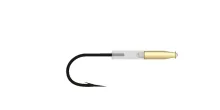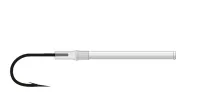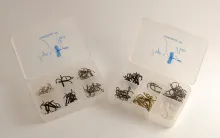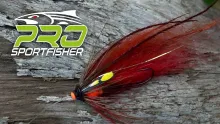Tube flies - like most other fly types - come in as many shapes and styles as you can imagine. This article merely scratches the surface in an attempt to list some of them. I also touches upon a few aspects of tying one tubes.
Until now I have only covered the tubes and the accessories and not touched upon specific patterns. It will not be within the scope of this article to do so, but nevertheless I will shortly mention some of the many styles of flies tied on tubes and provide examples
Different basic styles
Hair wing salmon - Temple Dog style
Håkan Norling's Temple Dogs have been hugely influential on particularly the Scandinavian style of tube flies, but they have also spread to both east and west, to Russia and to the US and Canada. The style will typically feature a large and high, often colorful wing over a body with tail, tag, hackle, rib etc. Many of the flies are tied with several wing sections parted by hackles that lift and support the wing, which is tied with soft hair such as Arctic fox or "temple dog" with the last section tied in Norling's "reversed" manner, meaning that the final bunches of hair in a hair wing are tied in in reverse order pointing forwards and then folded back and secured in this position with a small "wall" of tying thread. This method will give you a very high riding wing with a significant front profile.
Hair wing salmon - Sunray Shadow style
The Collie Dog, Sunray Shadow, Stoats Tail... these flies are the really simple ones, which are essentially just a wing on a bare tube. No body, no tail, no tag or anything else. Mostly they just consist of a long hairwing and a few straws of flash or a couple of peacock herl. Some flies are more complex with several materials and more colors, but they are still very simple.
In the round - Garry Dog style
These flies come from a British tradition and are often dressed in the round or at least symmetrical and very slender in shape. They are mostly dressed on copper or brass tubes and use fairly stiff materials such as bucktail over a non-hackled body, which enables them to go deep into the fast water of cold spate rivers.
Poppers and foam flies
Tubes are perfectly suited for light and floating flies, and many popper style flies for bass and saltwater species have been transferred to tubes. Really large flies like flies for marlin, sailfish and tuna tied in the Konahead-style are also perfect for tubes.
Shrimps - Francis style
Short bottle tubes lend themselves very well to shrimp-like patterns. Both more naturalistic shrimps as well as the shrimp-style salmon flies often tied on double and treble hooks, can be tied on tubes with very good results. The Francis with its antennae and the Icelandic Snelda are prime examples of this type of fly.
You can even buy specially tapered tubes meant for shrimp and crayfish patterns.
Built-up saltwater flies
Many contemporary saltwater flies tied on tubes are more like small constructions built on tubes. They incorporate different foams, glues, epoxies and other materials that allow the tyer to create some very lifelike flies with structure and color very close to the natural.
Muddlers
Muddlers of almost any shape and size are perfect for tubes. The large diameter of the tube make these large volume flies even larger, and you have different options of tube materials - plastic for light flies like deer hair poppers or Dahlberg-style divers, brass for deep diving flies such as sculpin patterns.
Creative
Tubes seem to get the best - or maybe rather the craziest - out in some people, and some of the most inventive and creative fly tyers have chosen the tube road and managed to create some really different and fascinating flies with some surprising choices of materials and tying methods.
|
|
|
|
|
|
|
|
Hooks for tubes
Since the tubes allow for a free hook choice you can vary the way you arm your tubes greatly. The factors you can play with are:
- number of points
- size
- color
- orientation
Whether you choose single, double or treble hooks can depend on your temper and local rules. Trebles have long been the default choice for tubes, but more and more Scandinavian anglers opt for double hooks. In the US and Canada the single hook is often chosen due to rules on the water and the desire to harm the fish as little as possible before a release.
The size will usually depend on the size of the fly, but personal taste and application influences the choice. Modern tube fly hooks come in a wide variety of sizes typically ranging from #12 to about #2, but you can use other types of hooks, short shank, straight eye saltwater hooks and bait fishing hooks as the most popular alternatives to tube flies. This will open up for much larger sizes up to 2/0, 3/0 and 4/0 hooks, which can be used as long as the eye will fit into the rear part of the fly or the junction tube.
Generally it's a good idea to keep the hook light and not too large. Even large flies can be equipped with small hooks as long as they are constructed with good clearance for the hook point.
Hook color is another variable that you can fool around with. Most traditional tube hooks are japonized black, but today you can also get silver and steel-gray tube fly double and treble hooks, and if you want to venture into the realm of the really colorful non-tube hooks the selection will extend to brass, gold, bronze and even hooks anodized in bright colors such as red, blue and green.
When using a hook fixed with a junction tube you have a fourth variation that is unavailable on flies tied on hooks: turning the hook. Treble hooks will fish and hook almost the same way no matter how you turn it, while the orientation of doubles and singles has a significant impact on the behavior of the fly and it's ability to fish and hook. Many users of double hooks in particular will swear by a hook turned upside down, fishing points up. The claim that this setup will make your fly move better in the water, give you less bottom snags and hook more fish.
Dressing the hook, several sections
You can also dress the hook, and add color and physical balance to the fly. You can have hooks dressed with different materials and colors. Hackles, dubbing and marabou are popular materials, but adding a dab of colored varnish or glue over the shank is also popular.
Tony Pagliei's Convertible Tube Flies is probably the most well known usage of this concept. His system consists of a head section dressed on a tube and a tail section dressed on a hook. These can then be combined in all manners and ways to create new flies with different materials, colors, weights etc.
Many saltwater flies and flies like the Banderillas rely on the dressed hook or several sections of dressed tubes joined on the tippet. In Iceland your also encounter anglers with two Snelda's - a large and heavy local pattern - on the tippet at the same time.
- Log in to post comments





























I tie tube flies for
I tie tube flies for warm water species such as bass and bluegill.I have used your tube fly articles as my number 1 resource ever since they have been published.In fact,globalflyfisher.com is a most valuable bookmark for me.
Excellent article, I
Excellent article, I've been trying to figure out how to tie some patterns on circle hooks and this gives me the ability to do just that. I prefer to use circle hooks for all my fishing due to the advantage of the hook's tendancy to hook only at the mouth of the fish. I do a lot of catch and release and the circle hook keeps damage to the fish to a minimum. Thanks!
I've just recently s
I've just recently started tying tube flies on Frodin and Eumer components. I enjoy all the help this thred gives. Thanks............
ive always wanted to
ive always wanted to tie tube flies but never knew how to get started and all these articles really helped. thanks so much and keep up the great work
these articles are g
these articles are great for a person just learning to tye tubes
thanks
Great tube fly artic
Great tube fly article series! Thanks a lot!!
Well !!! there you g
Well !!! there you go again, using me as an example of crazyness *LOL* Luckily I'm not hampered by paranoia. I found the tube fly articles most informative but in your section on hooks you did leave out one style though, the 180 degree double opposed hook. It's sort of a UK thing but after I was introduced to them by a UK type I started to use them in Alaska with amazing results (I even have a pic or two someplace). Often salmon are solidly packed in a stream and foul hooking is the order of the day. The 180 Deg hook eliminates a lot of that yet hookups by mouth are better than a single hook. Go figure
This is amazing - ve
This is amazing - very userfriendly and also covers everything there is to know bout tubeflies! Why by a book? Thank you very much for this!!